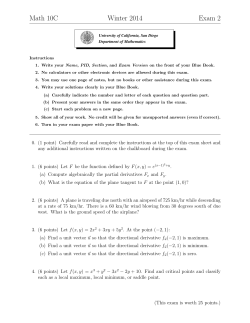
Name: Score: /8 Math 1321 Week 8 Lab Worksheet Due Thursday
Name: Math 1321 Score: Week 8 Lab Worksheet /8 Due Thursday 10/30 1. Partial Derivatives: (a) (1 point) Suppose z = (1 + xy)y . Find first partial derivatives ∂z ∂z , . ∂x ∂y Solution: ∂z = y(1 + xy)y−1 · y = y 2 (1 + xy)y−1 . ∂x When differentiating with respect to y, we rewrite z as z = ey ln(1+xy) . Therefore, ∂z xy y ln(1+xy) 0 y =e [y ln(1 + xy)] = (1 + xy) ln(1 + xy) + . ∂y 1 + xy ∂ 2z ∂ 2z ∂ 2z y , , . (b) (1 point) Suppose z = arctan . Find second partial derivatives x ∂x2 ∂x∂y ∂y 2 Solution: − xy2 y ∂z = . 2 = − 2 y ∂x x + y2 1+ x Therefore, 2xy ∂ 2z = 2 , 2 ∂x (x + y 2 )2 and ∂ 2z ∂ = ∂x∂y ∂y ∂z ∂x = y 2 − x2 2y · y − (x2 + y 2 ) = . (x2 + y 2 )2 (x2 + y 2 )2 Similarly, 1 x ∂z x = , 2 = 2 y ∂y x + y2 1+ x and thus ∂ 2z 2xy =− 2 . 2 ∂y (x + y 2 )2 (c) (1 point) Show that u = z arctan x ∂ 2u ∂ 2u ∂ 2u satisfies the Laplace’s equation 2 + 2 + 2 = 0 y ∂x ∂y ∂z Solution: Similar to part (b), ∂ 2u 2xyz =− 2 , 2 ∂x (x + y 2 )2 and ∂ 2u 2xyz = 2 . 2 ∂y (x + y 2 )2 Also since we have ∂ 2u ∂ = 2 ∂z ∂z x arctan y = 0, ∂ 2u ∂ 2u ∂ 2u 2xyz 2xyz + 2 + 2 =− 2 + 2 + 0 = 0. 2 2 2 ∂x ∂y ∂z (x + y ) (x + y 2 )2 2. Directional Derivatives and Gradient Vector: Suppose f (x, y) = x2 − xy + y 2 . (a) (1 point) Find all the directional derivatives at (1, 1), i.e. Du f (1, 1), with u = (cos α, sin α). Solution: Compute the directional derivative using gradient, Du f (x, y) = ∇f ·u = (2x−y, 2y−x)·(cos α, sin α) = (2x−y) cos α+(2y−x) sin α. Plugging in (x, y) = (1, 1), we have Du f (1, 1) = cos α + sin α. (b) (1 point) When does the directional derivative get to its maximum? its minimum? When is the directional derivative 0? Solution: We can do this in two ways. First, we can take the derivative of Du f (1, 1) with respect to α, i.e. the standard process of how to find maximum and minimum values in single variable calculus. Or we can use the proposition in the text book, that the directional derivative gets to its maximum when the directional vector has the same direction as the gradient, and that the directional derivative gets to its minimum when the directional vector has the inverse direction as to the gradient. In this specific case, the directional get √ derivative √ 2 2 π to its maximum when α = 4 and the directional vector u = ( 2 , 2 ), and the directional derivative get to its maximum when α = 5π and the directional 4 √ √ vector u = (− 22 , − 22 ). The directional derivative is 0 when cos α + sin α = 0, or equivalently, tan α = −1. Therefore, α = 3π 4 or 7π , 4 √ and u = ( √ 2 2 , − ) 2 2 √ or (− √ 2 2 , ). 2 2 3. Wind-Chill The wind-chill index W is the perceived temperature when the actual temperature is T and the wind speed is v so, we can write W = f (T, v). (a) (2 points) The following table of values is an excerpt from Table 1 in Section 11.1. Use the table to find a linear approximation to the wind-chill index function when T is near −15o C and v is near 50km/h. (b) (1 point) Estimate the wind-chill index when the temperature is −17o C and the wind speed is 55km/h. Solution: (a) From the table, f (−15, 50) = −29. By definition, f (T + h, v) − f (T, v) h→0 h f (T, v + h) − f (T, v) fv (T, v) = lim h→0 h To estimate fT (−15, 50) and fv (−15, 50), we follow a procedure similar to that given in Section 11.3 of your textbook. Based on the values given in the table, we approximate fT (T, v) = lim f (−15 + h, 50) − f (−15, 50) h→0 h fT (−15, 50) = lim using h = ±5. Thus, f (−10, 50) − f (−15, 50) −22 − (−29) 7 = = 5 5 5 f (−20, 50) − f (−15, 50) −35 − (−29) 6 fT− (−15, 50) ≈ = = −5 −5 5 fT+ (−15, 50) ≈ Averaging these values, gives fT (−15, 50) ≈ fT+ (−15, 50) + fT− (−15, 50) 13 = = 1.3 2 10 Similarly, we approximate f (−15, 50 + h) − f (−15, 50) h→0 h fv (−15, 50) = lim using h = ±10. Thus, f (−15, 60) − f (−15, 50) −30 − (−29) −1 = = 10 10 10 −27 − (−29) −2 f (−15, 40) − f (−15, 50) = = fv− (−15, 50) ≈ −10 −10 10 fv+ (−15, 50) ≈ Averaging these values, gives fv (−15, 50) ≈ fv+ (−15, 50) + fv− (−15, 50) −3 = = −0.15 2 20 The linear approximation to the wind-chill function, then, is f (T, v) ≈ f (−15, 50) + fT (−15, 50)(T − (−15)) + fv (−15, 50)(v − 50) f (T, v) ≈ −29 + 1.3(T + 15) − 0.15(v − 50) f (T, v) ≈ −2 + 1.3T − 0.15v Remark: In the process of approximating partial derivatives, it is also acceptable to use only one sided approximation of derivatives, i.e. only use h > 0 or h < 0. (b) Using the linear approximation found in part a, we estimate the windchill index when the temperature is −17o C and the wind speed is 55km/h as f (−17, 55) ≈ −2 + 1.3T − 0.15v = −2 + 1.3(−17) − 0.15(55) ≈ −32.35o C
© Copyright 2025














